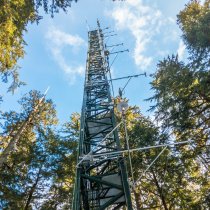NEON Science Explained Videos Bring Ecology Concepts to Life
May 8, 2018
What's the best way to forecast ecological changes? How do botanists measure photosynthesis? And what in the world is eddy covariance? You can find the answers to these and other questions on the NEON Science YouTube Channel. The Science Explained videos aim to make the science behind the NEON project simple.
The newest video, Ecological Forecasting: The Science of Predicting Ecosystems, explains how scientists use models to forecast ecological changes over seasons, years or decades. The video was produced in collaboration with Dr. Michael Dietz, an ecologist at Boston University. Michael is using NEON data to advance the field of near-term ecological forecasting using an iterative approach for more accurate predictions over short time scales.
The videos are part of an ongoing effort by Battelle scientists to help researchers, science educators, students and the public understand the methods used and data collected by the observatory network. Megan Jones, a Battelle staff scientist and a science educator for the NEON project, explains, "Part of our mission is to promote ecological understanding around the globe. We want people to use the data we are collecting, not just today but in the future. The videos are helping us get the next generation of ecologists interested in the data that are available to them."
So far, the team has produced nine Science Explained videos, with topics ranging from spectral remote sensing to measuring plant phenology. These short animated explainer videos present complex concepts in an engaging and accessible manner, with a healthy dose of humor. Colin Williams, the animator who creates the videos, says, "We work really hard to make sure we have the science right. But it's also important that the videos keep people's attention. Using humor keeps people engaged with the content and makes it more memorable."
Megan and Colin say more Science Explained videos are planned for the future, with topics yet to be decided. "We try to focus on topics that haven't already been covered other places," Megan says. "Ideas may come from questions we get from the science community or in the comments for our other videos. Others may be related to a paper coming out of the NEON data or a particular method or technology we are using."
The Science Explained video series is just one part of the education and outreach efforts coming out of the NEON project. Battelle scientists working on the NEON project are also taking part in workshops and conferences, writing papers and providing direct subject matter support to researchers who are interested in leveraging NEON data. In addition to the Science Explained series, the NEON Science YouTube Channel includes overview videos explaining the NEON project, more in-depth technical explanations of NEON methods and technology, and interviews with students and researchers using NEON data.
"The NEON project is public science," says Megan. "It's important for us to be transparent and get the word out about the data and resources we have available to the science community. Our YouTube channel is part of that effort."
If you have ideas for other videos, or have feedback on the existing videos, please get in touch!


